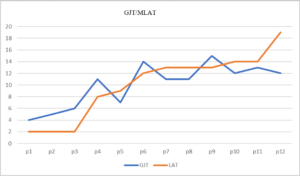Learning Content & Research-Based Teaching
Student Project Showcase
Acquisition of the English Article System in Year 5 Primary School Students
by Katarina Strmić (University of Rijeka)
As a fundamental feature of grammar, articles play an important role in mastering the English language. However, a considerable number of second language (L2) learners of English have problems fully acquiring the article system. The study my colleague and I conducted explored the acquisition of the English article system by Croatian L2 learners and compared it to their language aptitude scores. Language aptitude refers to an individual’s natural ability or potential to learn and acquire a new language.
The article system is a crucial aspect of English grammar, with the indefinite article ‘a’ and the definite article ‘the’ being two of the ten most frequently used words in English. These words play an important role in encoding various linguistic notions, such as existence, reference, attribution, discourse, countability and number. More specifically, articles denote the linguistic category of definiteness and indefiniteness. According to Katica Balenović, this category is often regarded as a linguistic universal or a constituent of learners’ linguistic knowledge that can be found in every human language. In contrast to English, Croatian uses cases, adjectives, and the numeral ‘one’ and the indefinite ‘some’ to express the notions of definiteness and indefiniteness. This difference in expression of (in)definiteness and the lack of articles in Croatian makes the acquisition of these elements difficult for Croatian L2 learners of English.
Aim of the study and the hypothesis tested
So far, much of the work on the L2 acquisition of English articles has concentrated on adult learners. For this reason, we decided to explore the acquisition of the English article system in primary school students, more precisely in Year 5 students. All the participants in the study were native speakers of Croatian with English as their L2. The aim of the study was to explore the relationship between Croatian primary school students’ language aptitude and their knowledge of the English article system. My colleague and I hypothesized that there would indeed be a relationship between these two variables.
Participants and tests
A total of 12 Year 5 primary school students took part in the study. They all started learning English in Year 1 and had never lived in an English-speaking country. Given that all students were underage, only those whose parents signed an informed consent form participated in the study. Out of the 12 participants, six were male and six female.
We collected data anonymously by means of three different tests: a background questionnaire, a language aptitude test and a grammaticality judgment test (GJT). The background questionnaire consisted of 11 questions targeting the participants’ socio-demographic and linguistic backgrounds. The language aptitude test consisted of 12 questions and was based on the Modern Languages Admissions Test (MLAT). It consisted of three parts and was aimed at measuring the participants’ ability to recognize and apply grammatical and lexical rules of an imaginary language (Noladi) to different sets of sentences. The GJT contained 50 sentences. Participants were asked to indicate whether each sentence was correct, incorrect, or if they were uncertain about it. Out of the 50 sentences, 24 targeted the English article system and measured participants’ knowledge of the definite and indefinite articles. The study was conducted in person during regular class time and it lasted 90 minutes.
Results
The individual scores for the GJT ranged from 12 (out of 24, that is 50%) to 4 (16%), with a mean score of 10.08 (SD=3.49). These relatively low scores indicate that articles are a difficult concept to learn for the L2 learners that participated in our study.
As for the MLAT, the highest score was 9.5 (19%) and the lowest was 1 (2%) out of the possible score of 51. We attributed these relatively low scores to the difficulty of the test and the limited time the participants had at their disposal for doing the test.
By examining the relationship between the results of the GJT and the MLAT, we concluded that there is a connection between language aptitude measured by the MLAT and knowledge of the English article system measured by the GJT. More precisely, as the scores on the MLAT increase, so do the scores on GJT. It can be seen in Figure 1 that the results of the GJT and the MLAT overlap.
Figure 1. Individual participants’ scores on the GJT and the MLAT
Discussion and connection with previous research
The results suggest that the English article system is a difficult concept for the L2 learners that took part in our study. This is consistent with the results of previous studies. Tatiana Zdorenko and Johanne Paradis found that L2 learners whose L1 does not include articles have difficulty learning what definiteness and indefiniteness in their L2 are. Moreover, Katica Balenović concluded that there is inconsistency in the use of definite and indefinite articles in Croatian L2 learners of English with the tendency to omit articles.
According to Vlad Žegarac, the Relevance Theory can be applied to the acquisition of the English article system by L2 learners. This theory suggests that L2 learners focus on their surroundings based on their perception of relevance, and use ostensive stimuli and their interpretation called ostensive-inferential communication to create a view of the phenomena’s relevance. An ostensive stimulus is intended to grab the attention of a listener and direct it towards the intended meaning of the communicator. By using an ostensive stimulus, the listener may develop specific and reliable expectations about what is relevant, which may not occur with other forms of input. This approach can be connected to the acquisition of articles in L2 learners as they need to recognize the use of definite and indefinite articles in various situations. Learners’ brains do not recognise how to turn declarative knowledge (information) into procedural knowledge (usage) which is needed to understand when to use articles ‘the’, ‘a’, ‘an’, or ꝋ. This means that no picture in the speakers’ mind shows the difference between, for example, ‘a bottle’ and ‘the bottle.’ This can be seen in the results of this study. For example, only five (41%) of the participants judged correctly that the pair of sentences ‘A night is quiet. Let’s take a walk’ is incorrect. The correct version of the sentence pair would be ‘The night is quiet. Let’s take a walk.’. This points to a lack of understanding of the definiteness: the participants did not develop a picture of the particular night that is being referred to in their minds and thus could not associate it with the definite article.
Despite general alignment, some results of our study differ from the results of previous studies. More precisely, Tatiana Zdorenko and Johanne Paradis report that the definite article ‘the’ is usually acquired prior to the indefinite articles ‘a’ and ‘an’. In our study, fewer errors were found in the sentences targeting indefiniteness (43.33%, SD=22.85) than those targeting definiteness (39.08%, SD=13.8).
When it comes to the relationship between language aptitude and knowledge of the English article system, mainly the concepts of definiteness and indefiniteness, our results pointed to the existence of the connection between language aptitude and the understanding of the English article system.
Limitations of the study and directions for future research
The study we conducted had several limitations. First, the number of participants was low, and only one type of test was used to measure their knowledge of articles. Second, all the participants in the study were of similar age (11 years), and they were all learning English for a similar amount of time. In future research, a higher number of participants should be tested, and more, and additional ages and institutional levels could be included. Other test types, such as production or comprehension tests, could be used to test L2 learners’ knowledge of the English articles. Furthermore, future research could look at the effects of the different methods of instruction on the knowledge of the English article system.
The most important take-home message from this study for the teachers of English as a foreign language is that the language aptitude of L2 learners affects their mastery of the English article system. Considering this, teachers could assess their students’ language aptitude, preferably when they start teaching them. Following this, they could devise and use different ways of teaching articles according to each learner’s needs.
Have you ever wondered about the inner structure of words used every day during speech? Chances are you haven’t. But hear me out. Linguists have been trying to figure out all sorts of things about language as a human phenomenon to ultimately draw conclusions about how our brain works and even what it means to be a human. Studying words’ structure is a separate field within general linguistics and is called morphology.
As a student of linguistics, I have been particularly interested in morphology and I have recently worked on a project while attending a research-based class given by Marko Simonović who was also my mentor. I created this blog post not only to present this project, but also to illustrate what it means to be a theoretical linguist: What are the questions we are interested in, and how do we try to answer them?
In the blog post, I present how I analysed Slovene words and their structures to see how they are seen by the brain. It is not yet fully known what greater outcomes the linguistic research findings may lead to. However, examining smaller phenomena from various languages to see the bigger picture about language brings a better understanding of us and the world around us.

Katarina Strmić
I’m a master’s student of English Language and Literature and Pedagogy in the Faculty of Humanities and Social Sciences at the University of Rijeka, Croatia. In my faculty, I also fulfil the role of a Student Ombudsman, working to promote student rights and ensure fair treatment for all students. I have a diverse range of interests and experiences, including organizing both a book and a movie club, and working as a waitress, secretary, professional cleaner and salesperson. Overall, I’m always looking for new challenges and opportunities to learn and grow. Whether it’s organizing a club, working in a customer-facing role, or advocating for the rights of my fellow students, I approach every task with enthusiasm.
View my LinkedIn profile

